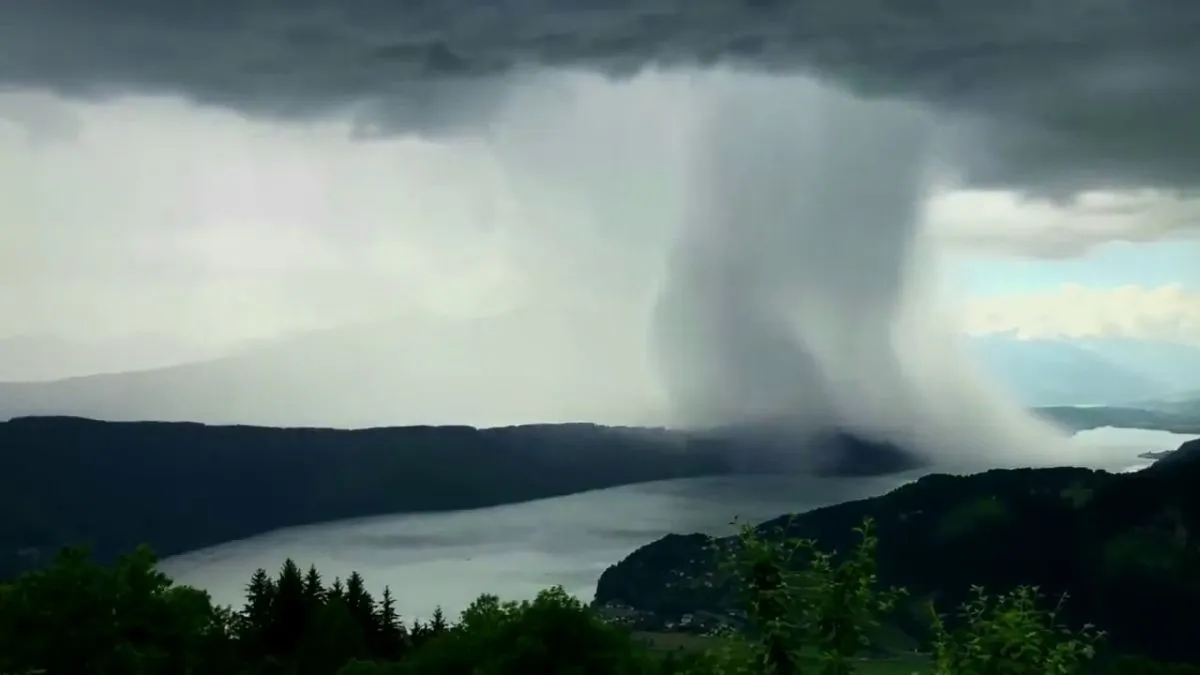Cloudburst hit Uttarkashi district in India’s northern Himalayan state of Uttarakhand on August 5, unleashing devastating flash floods and landslides that wiped out entire villages, swept away roads, ad isolated some areas completely. At least four people have been confirmed dead, while over 50 remain missing. The tragedy unfolded in Dharali village, where the deluge overwhelmed both natural drainage and man-made infrastructure. The disaster prompted large-scale rescue operations by the Indian Army, Indo-Tibetan Border Police (ITBP), National Disaster Response Force (NDRF), and State Disaster Response Force (SDRF). Later the same day, a second cloudburst was experienced in Sukhi Top, which heightened the crisis in the already suffering region.
What Is A Cloudburst?
A cloudburst is an intense, sudden rainfall phenomenon in which over 100 mm of rain may occur within less than one hour in a specific localized area. They are usually caused by the sudden upward rush of warm, humid air into cumulonimbus clouds that lead to condensation and instant precipitation. The steep slopes of mountain ranges such as the Himalayas provide a catalyst that compels air to rush upwards rapidly, increasing the chances of these destructive weather phenomena.
The reason cloudbursts can be so devastating is their speed and force. Unlike normal monsoon rains, a cloudburst releases a huge amount of water in a short time, usually inundating riverbanks, roads, and drains. On hilly terrain, it causes flash floods and landslides that ravage houses, cars, and even villages. Timely evacuations and response are hindered by the absence of early warning systems, as well as challenging terrain. Flash floods, resulting from the sudden discharge of water during cloudbursts, are among the most lethal natural hazards in the world. They provide minimal or no warning and can sweep away houses, bridges, roads, and even hydroelectric dams.
Why Are Cloudbursts Becoming More Frequent?
Scientists globally agree that climate change is a key driver behind the rising frequency and severity of cloudbursts. Here’s why:
• A warmer atmosphere holds more moisturearound 7 per cent more for every 1°C rise in temperature. This intensifies storms when the moisture is eventually released.
• Changing monsoon patterns, driven by warming oceans and shifting jet streams, are causing rain to fall in shorter, more intense bursts.
• Rapid snow and glacier melt in the world’s high mountains—such as the Himalayas and Andes, adds further water volume to already overwhelmed rivers.
“The data is clear. What used to be considered ‘once-in-a-century’ rainfall is now happening every few years in some regions,” said Dr. Lisa Cortez, climate hydrologist at the World Meteorological Organization (WMO).A 2023 Nature study found that Indian extreme rain events have risen by 20–50 per cent across most parts of the country since the 1950s. India’s Meteorological Department also attests to a consistent increase in cloudburst events, especially in Himachal Pradesh, Uttarakhand, and Jammu & Kashmir—states constituting the IHR’s nucleus.
Not Just India: Global Boom In Catastrophic Cloudbursts in 2025
India (August 2025)
Repeated cloudbursts in Uttarakhand and Himachal Pradesh resulted in lethal flash floods and landslides, claiming dozens of lives and leaving others missing. Hydropower infrastructure was heavily destroyed throughout the area.
Pakistan (June–July 2025)
Heavy monsoon rains resulted in cloudburst-like flooding in Punjab and Khyber Pakhtunkhwa, claiming more than 32 lives and causing extensive damage to agriculture and infrastructure.
Nepal (July 8, 2025)
A glacial lake outburst caused by heavy rain precipitated devastating flooding in Nepal’s Rasuwa district, affecting residents on both sides of the border in Nepal and Tibet.
United States
• Texas (July 4–5): Central Texas experienced a record deluge that overpowered the Guadalupe River with record levels, claiming more than 130 lives.
• New Mexico (July 8): Flash floods in a wildfire-scarred area of Ruidoso resulted in several fatalities and stranded several.
• New York/New Jersey (July 14): Cloudbursts triggered subway closures, property damage, and deaths in the New York metropolitan region.
These occurrences demonstrate that cloudbursts are no longer an issue confined to sensitive mountain ecosystems—they are hitting major metropolises, floodplains, and even arid regions with frightening frequency.
Why Some Places Are More Vulnerable?
The geography and weather patterns of the Himalayas render them a cloudburst hotspot:
• Orographic lifting: Moist air is forced upward by mountain slopes, triggering intense condensation.
• High humidity & warm updrafts: Combine to hold large volumes of water in clouds, which is suddenly released when updrafts weaken.
• Unregulated development: Deforestation, damming of rivers, and poorly planned construction in ecologically fragile zones increase vulnerability.
What Can Be Done?
To reduce the impact of cloudburst-induced disasters, governments and global institutions must prioritise:
• Satellite and AI-based advanced weather monitoring.
• Early warning systems at the community level, particularly in rural and mountainous areas.
• Sustainable land-use planning that avoids over-development of sensitive areas.
• Reforestation and restoration of ecosystems for enhanced natural water absorption.
• Urban climate resilience infrastructure, particularly in megacities.
ALSO READ: Death, Destruction And Downpour: How Texas Is Fighting Back After Deadly Floods | See in Pics
Cloudbursts are no longer exceptional, localised phenomena. They are a symptom of a changing climate, and they’re arriving sooner and harder, whether in Uttarkashi or Texas, Kathmandu or New York City. As the planet continues to heat up, these extreme, short-lived rainfall events are projected to grow in frequency as well as magnitude. Policymakers, researchers, and communities need to now address cloudbursts as an issue of the international climate crisis, rather than merely a local aberration.
